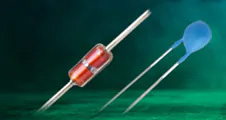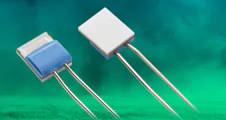Sensors have become an essential part of many devices and systems. When it comes to measurement of physical or environmental conditions, temperature is one of the most measured parameters for a multitude of purposes. Measuring temperatures might seem trivial. After all, we are accustomed to measuring air temperature using a thermometer when checking the weather. However, when it comes to designing an electronic device or system that requires temperature measurement, designers have many options at their disposal. At times, selection of the best temperature sensor can be a daunting task. Fortunately, two temperature-sensing technologies offer the features and functionality required for a wide range of uses. Those two technologies are the negative temperature coefficient (NTC) thermistor and the resistance temperature detector (RTD). Here, we will detail the differences between NTC thermistors and RTDs and how they are best suited to meet the temperature measurement accuracy requirements of a wide range of designs.
NTC Thermistors
NTC thermistors are thermally sensitive resistors that exhibit a negative temperature coefficient of resistance by decreasing in resistance as temperature increases (Figure 1). This non-linear relationship between resistance and temperature can be beneficial when accurate temperature measurement is needed within a relatively narrow range of temperatures, say within a window of 50°C. The nearly exponential change in resistance value for every degree centigrade in temperature change allows temperature to be measured with little error.

Figure 1: NTC Thermistors provide highly accurate temperature measurements within a relatively narrow range of temperatures. (Source: Mouser Electronics)
NTCs are made of ceramic metal-oxide semiconducting materials that vary in resistance versus temperature characteristic based on the specific materials used in their formulation mix. They can also come in various shapes and form factors and can be used in a wide variety of applications. Since they are a type of variable resistor, their signal is a resistance value, which is an analog value. NTCs are often used in an analog measuring circuit where the resistance change can be linearized by the use of a voltage divider and operational amplifier circuit. The measured resistance value is converted to a temperature reading by either looking up the value in the thermistor’s published resistance versus temperature table or by calculating the temperature using an approximation equation.
When determining the best type of NTC thermistor to use for measurement accuracy, a designer must be familiar with the types of thermistor calibrations available. NTC thermistors might be point-matched, where they are calibrated with a resistance tolerance at a single temperature (typically 25°C) or a few discrete temperature points. Point-matched NTCs with resistance tolerance of 1 percent, 3 percent, 5 percent, and 10 percent at 25°C are commonly available in the market. Alternatively, NTCs can be interchangeable, where they are calibrated to maintain a window of temperature accuracy (for example, ±0.1°C) within a range of operating temperatures. Interchangeable NTC thermistors are designed for use where they can be replaced with a thermistor from another manufacturer without the need to re-calibrate the measuring circuit. NTCs with temperature accuracy of ±0.1°C and ±0.2°C are commonly available in the market and are economical solutions for temperature measurement.
Resistance Temperature Detectors (RTDs)
RTDs are thermally sensitive resistors similar to NTC thermistors. However, unlike NTCs thermistors, RTDs exhibit a positive temperature coefficient of resistance—that is, they increase in resistance as temperature increases (Figure 2). The resistance versus temperature relationship for an RTD is nearly linear for a wide range of temperatures. This linear response can be beneficial when it comes to ease of converting a resistance reading into a temperature value. This characteristic also makes RTDs more suitable for use in applications where measurements are made over a wide range of operating temperatures (for example, over a range of -50°C to 500°C.

Figure 2: RTD exhibit a nearly linear relationship between resistance and temperature, which make them especially useful when converting a resistance reading into a temperature value. (Source: Mouser Electronics)
Unlike NTC thermistors, RTDs are made of precious metals that are either formed into a wire-wound resistor or deposited onto a substrate using a thin-film process. Most RTD devices use nickel or platinum as the sensing element, as these metals exhibit a very well-defined temperature coefficient of resistance over a wide range of temperatures. The Littelfuse portfolio of sensors contains thin-film platinum RTDs, also commonly referred to as Pt-RTDs, Pt-1000, or other Pt-xxxx values where xxxx represents nominal resistance.
Much like NTCs, RTDs are also used in analog measuring circuits to convert a resistance reading into a temperature reading. Often, RTDs are grouped with other resistors in a bridge configuration to allow a more accurate reading and to minimize error in resistance readings. For thermometers or temperature sensor assemblies containing RTDs, it is common to include additional wire leads to form a 3-wire or 4-wire configuration enabling resistance of the sensor’s wire leads to be removed from the measurement to get an even more accurate temperature reading from the RTD sensing element itself.
RTDs come in various accuracy classes, which are defined by various international standards. Platinum RTDs have accuracy classes defined by the standard IEC 60751. For thin-film platinum RTDs, the accuracy classes are defined as F 0.1, F 0.15, F 0.3, and F 0.6, where the number represents the temperature accuracy in ±°C at 0°C. For each of these accuracy classes, the temperature accuracy widens linearly as temperature increases or decreases away from 0°C. The temperature range in which each RTD maintains its accuracy varies by class, so it’s important to know over which range of temperatures the desired accuracy is required.
Summary
Although they both offer the same basic functionality of measuring temperature in the form of a resistance reading, NTC thermistors and RTDs are different technologies, each with their own set of benefits and features. When selecting the best technology for temperature measurement, it is essential to consider key parameters such as operating temperature range, the amount of accuracy required in the measurement, and the range of temperatures where measurements will be made, among other design factors. NTCs offer an economical solution for temperature measurement but could lack accuracy and stability when operating at temperature extremes. RTDs, on the other hand, provide excellent accuracy and stability, but at a higher cost. Ultimately, the balance between functionality and budget must be considered when selecting the best solution. Littelfuse offers a broad range of thermistors, resistance temperature detectors (RTDs), digital temperature indicators, and probes and assemblies for temperature-sensing applications. Beyond just the sensing element alone, Littelfuse also offers various custom sensor solutions.
